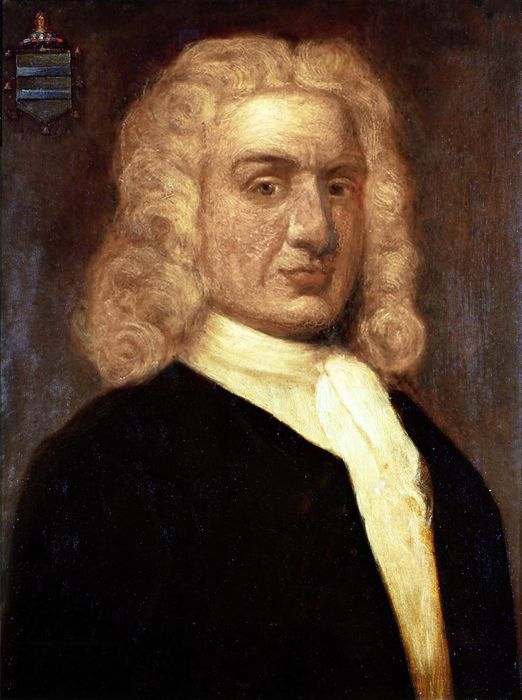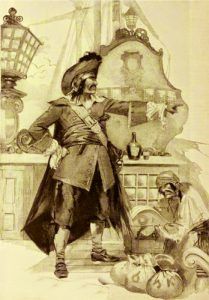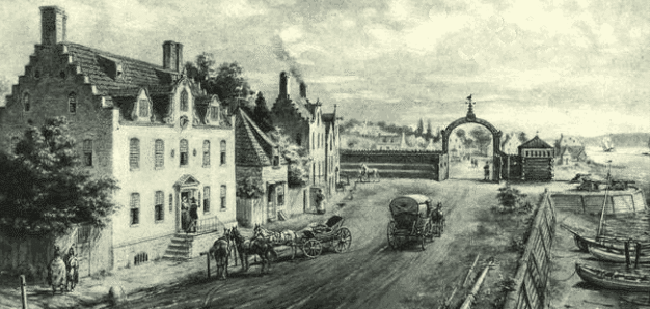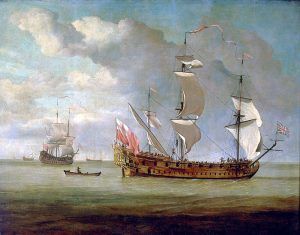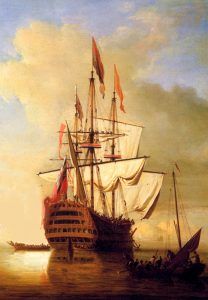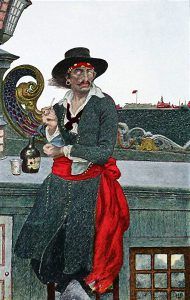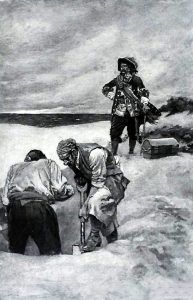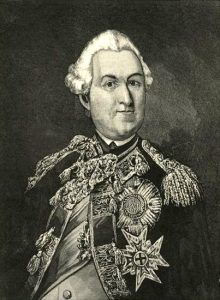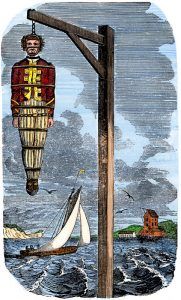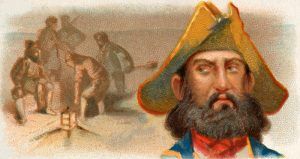Captain William Kidd was a 17th-century Scottish sailor who became one of the best-known privateers of his time. He began his career as a legitimate English Privateer before he was tried and executed for piracy in 1701.
William Kidd was born in Dundee, Scotland, in about 1654 to Captain John Kyd and his wife, Bessie Butchart. As a boy, his father was lost at sea, and a local society financially supported his family. When he was old enough, he went to work as a privateer for European royals to attack foreign ships.
A privateer was a non-military person, or ship engaged in maritime warfare under a commission of war. Privately owned merchant ships, licensed by the crown, could legitimately attack and take vessels deemed pirates or privateers from opposing nations. Captured ships were sold, with the proceeds divided between the privateer sponsors, shipowners, captains, and crew. In practice, the legality and actions of the privateers were often vague.
After working for various buccaneer crews, William became a respected privateer in his own right by the 1680s. At about this time, Kidd set sail for America and settled in New York City, where he befriended many prominent colonial citizens, including three governors.
By 1689, Kidd was a member of a French-English pirate crew sailing the Caribbean under Captain Jean Fantin. During one of these voyages, Kidd and other crew members mutinied, ousted the captain, and, in August, sailed to the British colony of Nevis in the Caribbean Sea. The ship, equipped with 16 guns, then became part of Nevis Governor Christopher Codrington’s small fleet, was renamed the Blessed William, and William Kidd became its new captain. Governor Codrington’s small fleet was tasked to defend Nevis from the French, with whom the English were at war.
As tensions increased between England and France, Captain Kidd’s influence grew as he was tasked with protecting English ships, not only in the Caribbean but also along the coast of New England. By 1690, he was an established sea captain and shipowner in New York City, where he owned property and, at various times, was dispatched by both New York and Massachusetts to rid the coast of enemy privateers.
On May 16, 1691, Kidd married Sarah Bradley Cox Oort, an English woman in her early twenties. Despite her young age, Oort had already been twice widowed and was one of the wealthiest women in New York, mainly because of her inheritance from her first husband.
He found such success in America and the West Indies that he was called back to England in 1695 to take on a new royal commission. While there, Kidd met the 1st Earl of Bellomont, Richard Coote, who became the governor of New York and New England.
In October 1695, the King’s officers offered Kidd a position apprehending pirates attacking the ships of the East India Company and capturing French ships in the Red Sea and the Indian Ocean. The seaman was to become the captain of a new ship called the Adventure Galley, equipped with 34 cannons and a crew of 150 men. Weighing over 283 tons, the vessel was also equipped with oars that would give it an advantage, as it could maneuver in battle even when the winds were calm. Kidd accepted the offer and personally selected his crew and officers for their skills, experience, and loyalty. Any confiscated booty would be divided between Kidd, his men, and his backers.
In May 1696, when the Adventure Galley set sail from Deptford, England, down the Thames River, the venture immediately got off to a bad start. Both captain and crew had been drinking during the launch party, and as they passed a Royal Navy ship, they failed to salute, which was customary and required. Insulted, the Navy fired a shot demanding that the seamen on the Adventure Galley show some respect but were rewarded by some crew members dropping their breeches, turning around, and slapping their backsides. In response, the Navy captain retaliated by pulling over the Adventure Galley and impressing many crew members into immediate service in the Royal Navy.
Short-handed, Kidd then sailed for New York City to restaff his crew. Unfortunately, some of these new members were not the same quality as those he had lost to the Navy. Some were known and hardened criminals, and others were former pirates. This detour created another problem as Kidd would not meet his agreed-upon return date of March 1697.
With an entire crew, the Adventure Galley set sail for Africa’s Cape Town. When he was about 100 miles from his destination, he stopped a Royal Navy vessel and demanded the captain supply him with new sails to replace those damaged in his trip across the Atlantic. When the captain refused, Kidd threatened to stop the first English merchant ship he saw and forcibly take its sails. To this, the Navy captain threatened Kidd with treason and impressed more of his men into service. That night, Kidd used the ship’s oars to slip away quietly and avoid Cape Town.
By about February 1697, the Kidd and his men made their way to the east coast of Africa, where they stopped for supplies. Many of the crew became ill, and before the ship departed, 50 of his men had died. They made their way to the mouth of the Red Sea, where the seamen faced more problems. Though the ship was only a little over a year old, it was beginning to show wear. The joints were loose, causing leaks, and the bottom was infested with shipworms.
In the meantime, they had run into very few ships other than fishing vessels and had taken no prizes of note. The men were getting restless, concerned about the lack of loot the ship had gained in the long journey, and tempers grew short. At some point, a gunner named William Morre argued with Captain Kidd and began talking about mutiny. Kidd responded by hitting the man in the head with an iron-bound bucket, knocking the man to the deck and fracturing his skull. Moore died the next day.
In early 1698, the Adventure Galley came upon a large merchant ship called the Quedagh Merchant, rounding the tip of India on its way to Bengal. Though the ship was owned by Armenians, captained by an Englishman named Wright, and crewed by Moors, who were Muslim inhabitants of North Africa, the ship was carrying a French Shipping License. This was enough for Captain Willliam Kidd, and though the Quedagh was much larger, weighing 400 tons, Kidd and his men attacked the ship and looted it for its Persian cargo, which included a treasure trove of gold, silk, spices, opium, sugar, and other riches, rumored to have been worth 70,000 pounds.
Having made a great achievement in Kidd’s mind, he abandoned the damaged Adventure Galley and ordered his crew to sail for New York on Quedagh Merchant.
But, the attack was one of a series of mistakes that Kidd had made during the voyage. Much of the booty on the Quedagh belonged to the powerful British East India Company, and other goods were owned by a minister at the Court of the Indian Grand Moghul, who had powerful connections. Further, his disrespect for the Royal Navy of England would haunt him, as the Navy Captains reported the confrontations and accused him of piracy.
Captain Kidd and his crew then went to the island of Hispaniola in the Caribbean in April 1699, where he learned that he and his crew had been accused of piracy. Sure that he could prove his innocence, he convinced his crew to return with him to New York, but rather than taking the Quedagh, he purchased a smaller ship called the Antonio and left the larger ship behind with some of the crew. Captain Kidd ordered the remaining crew to strip the Quedagh of her plunder, bury the goods, and burn the ship, which they did.
Once in New York, Kidd visited his wife and step-children and hired a lawyer. But, he had underestimated his bad decisions and the reaction of his financial backers and the public. He had taken far longer than planned for the expedition; he had failed to capture several pirate ships and returned without treasure to pay his financial backers. And what he couldn’t have known was that privateering, in general, had become a disfavorable practice.
Circumstances worsened when Captain Kidd turned over the French licenses from the Quedagh to his lawyer, who promptly gave them over to Governor Bellomont, who just happened to be one of the expedition’s backers. Afterward, the licenses mysteriously disappeared.
Making matters worse, Kidd, worried by this time, clumsily tried to bribe various people and hinted that he had buried vast riches.
William Kidd then tried to convince the British governor, the Earl of Bellomont, that he was innocent of the accusations against him. But, by this time, Kidd had already been viewed by the governor and other high-profile investors as a liability. In November 1698, orders were sent to arrest Captain William Kidd. In June 1699, Bellomont sent a message to Kidd, promising clemency. Kidd responded that he would come and arrive in Boston on July 3, and Bellomont demanded that he provide a written account of his travels by the morning of July 6. For whatever reason, Kidd was delayed that morning and was on his way to see Bellomont when the governor issued a warrant for his arrest.
After being arrested, Captain Kidd attempted to negotiate his freedom by providing secret locations of his treasure and a captured prize ship as bargaining chips. Although some of the treasure was recovered, Kidd was shipped to London, England, in April 1700.
Captain Kidd remained in prison in England for over a year before he was brought to trial and then not for piracy, as he had expected, but for having killed William Moore upon the high seas. Kidd’s defense was that Moore was the leader of a mutinous crew, but it is evident from the minutes of the trial that there was no question as to what the verdict would be. Though he should only have been convicted of manslaughter, the jury found him guilty of murder.
Having made sure that Kidd would be hanged, the Court next ordered him brought to trial under an indictment of piracy. Kidd asked for a postponement until his papers, particularly the two French Shipping Licenses, could be obtained and submitted as evidence, but the request was denied. The trial began on May 8, 1701, and Kidd expected Lord Bellomont and others would come to his defense, but they didn’t. He also anticipated that the French shipping licenses would be admitted as evidence that the ship was lawfully spoiled under his commission. But, the licenses had mysteriously disappeared.
After the sentence had been pronounced, Captain Kidd said:
“My Lord, it is a tough sentence. For my part, I am the innocentest of them; only I have been sworn against by perjured persons.”
On May 23, 1701, he was hanged at Execution Dock on the Thames waterfront at Wapping, and his body was placed in chains and gibbetted on the shore to serve as a warning against other pirates.
In the years after his conviction, some historians questioned whether the evidence was sufficient for guilty verdicts.
Captain William Kidd is often called “the most famous pirate” in history. But he was never the typical swashbuckling pirate of popular fiction. Instead, it appears that he should be mentioned as a famous privateer. He had successfully sailed for years and served his country before his final voyage on the Adventure Galley.
In the end, a few bad choices, coupled with the secrecy of the backers of the final voyage and the powerful influence of the East India Company, seemingly doomed the expedition from the start.
His fame in history comes more from the mystery of his hidden treasures than his actual exploits. Numerous stories have been told over the years of where he buried his loot, and despite generations of people who have looked for it, nothing has ever been found.
© Kathy Alexander/Legends of America, updated January 2024.
Also See:
Pirates – Renegades of the Sea
Sources:
Dow, George Francis and Edmonds, John Henry; The Pirates of the New England Coast, 1630-1730; Marine Research Society, 1923
Historic UK
History Today
The Pirate Empire
Vintage News
Wikipedia

